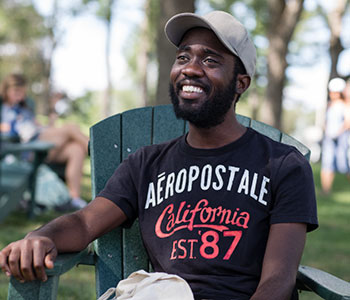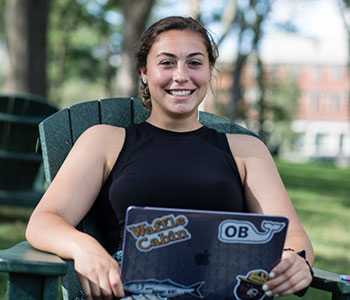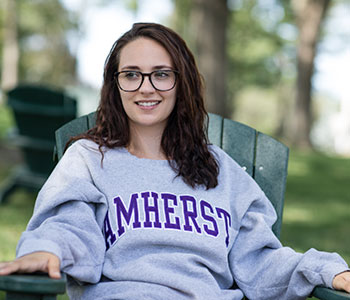At any given time, Amherst has about 60 students on campus who have transferred from other schools. About a dozen arrived in 2018.
Those transfer students were a diverse bunch, ranging in age from 19 to mid-30s, with some coming from community colleges and others from four-year institutions or the military.
One thing they had in common was their eagerness to make big changes in their lives.
Meet three of Amherst’s most recent transfers.
Brian Miller ’19

“I didn't do a tour or anything, just got off the bus—it was snowing—and pulled my suitcase all across campus,” he says. “I wasn't trying to get into a private, elite group of students. I was just trying to finish a four-year degree.”
He’d applied to transfer to schools in the CUNY and SUNY system, but an adviser suggested he look at Amherst.
“When I got my acceptance letter, one of my friends, who went to Williams, said, ‘You have to go. You just have to,’” Miller says. “It's one of the best decisions in my life.”
The transition wasn’t easy. As soon as he arrived on campus, he says, he started doubting himself and his accomplishments.
“I didn't even have the language for it. I remember talking to another transfer student, describing how I felt, and she said, ‘That’s imposter syndrome.’”
Miller eventually came into his own and decided to major in black studies: “I wanted to be able to speak to faculty about my experience, about the research I was doing, whatever I was thinking. I wanted to be able to interact with faculty of color, and in particular, black faculty.”
Now 26, Miller works part-time in the Office of Campus Diversity and Student Leadership. “Working in that office has made a huge difference,” he says, “because I’m able to form community with other first-generation and low-income students.”
Antonia Tammaro ’21

“At St. John's,” she says, “I was going to major in toxicology, I was going to fulfill pre-med requirements, play Division I soccer. Everything was set up.”
But she wanted to find her way herself. “I didn't want to go into college knowing why I came to college; I wanted to leave college knowing why I came to college.”
And while St. John’s had all the benefits of being in New York City, Amherst already feels like family, she says, noting that being at a small liberal art institution is allowing her to thoughtfully transition to adulthood.
Katherine Cyr ’19E

“When you're low-income and you go to a college like that, there’s a strong emphasis on the job—what are you going to do right away to make money? I took some early-education courses because they have a great program over there, and that wasn’t the best fit, so then that motivated me to explore the medical field.”
Cyr went to work as a registered medical assistant.
“I didn’t really think about transferring until it was actually time for me to graduate from community college and my math professor told me to apply here,” she says.
She will graduate from Amherst this winter with a double major in math plus an interdisciplinary major combining math, psychology and philosophy, with a strong focus on health care. Having researched the impacts of social networks on health care choices—motivated, she says, by seeing how hard the opioid crisis hit her hometown of Warren—she has her eyes set on graduate school for biostatistics.
Being a nontraditional student who has already been in the workforce can be disorienting, she says. “It’s surprising how many students here don’t know how to cook. I’ve been cooking since I was 10.” Now 22, she prefers to cook for herself in the dorm kitchen in Garman House.
“I was really surprised by the friendships that I developed here,” she says of Amherst. “A lot of people from my community don’t really go to college. A lot of my closest, best friends have two kids. I always felt like an oddball, but then when I came here, I found all the other oddballs.”
“Community” is a word that comes up a lot when talking with transfer students.
“Some of us transferred from community college, some of us transferred from more elite universities, some of us are international,” says Cyr. “We’re all very different, but the thing that unifies us is that we just want to hang out with each other. We’re just people who really care about the community and want to participate.”